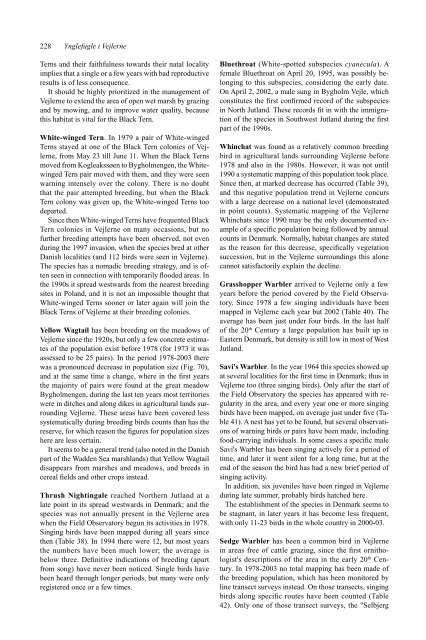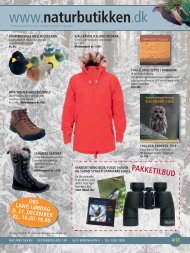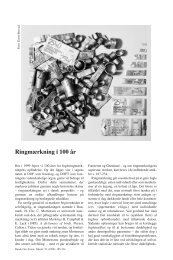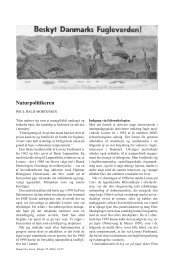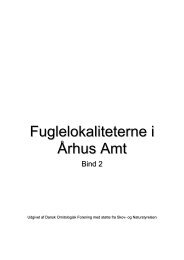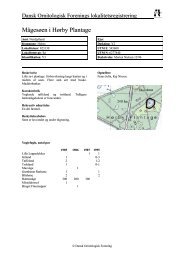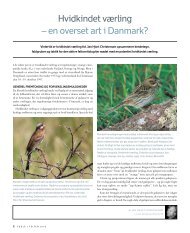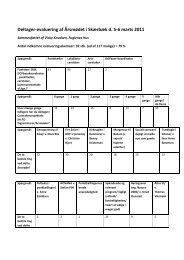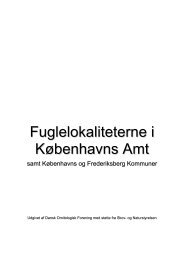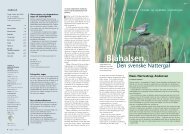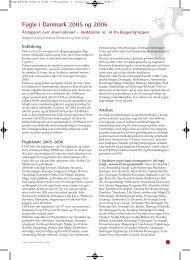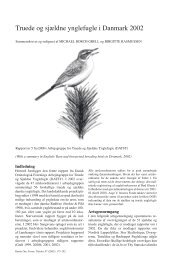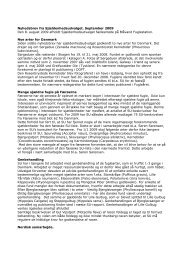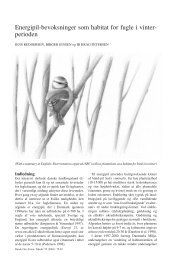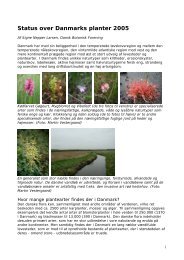Ynglefugle i Vejlerne - Dansk Ornitologisk Forening
Ynglefugle i Vejlerne - Dansk Ornitologisk Forening
Ynglefugle i Vejlerne - Dansk Ornitologisk Forening
Create successful ePaper yourself
Turn your PDF publications into a flip-book with our unique Google optimized e-Paper software.
228 <strong>Ynglefugle</strong> i <strong>Vejlerne</strong><br />
Terns and their faithfulness towards their natal locality<br />
implies that a single or a few years with bad reproductive<br />
results is of less consequence.<br />
It should be highly prioritized in the management of<br />
<strong>Vejlerne</strong> to extend the area of open wet marsh by grazing<br />
and by mowing, and to improve water quality, because<br />
this habitat is vital for the Black Tern.<br />
White-winged Tern. In 1979 a pair of White-winged<br />
Terns stayed at one of the Black Tern colonies of <strong>Vejlerne</strong>,<br />
from May 23 till June 11. When the Black Terns<br />
moved from Kogleakssøen to Bygholmengen, the Whitewinged<br />
Tern pair moved with them, and they were seen<br />
warning intensely over the colony. There is no doubt<br />
that the pair attempted breeding, but when the Black<br />
Tern colony was given up, the White-winged Terns too<br />
departed.<br />
Since then White-winged Terns have frequented Black<br />
Tern colonies in <strong>Vejlerne</strong> on many occasions, but no<br />
further breeding attempts have been observed, not even<br />
during the 1997 invasion, when the species bred at other<br />
Danish localities (and 112 birds were seen in <strong>Vejlerne</strong>).<br />
The species has a nomadic breeding strategy, and is often<br />
seen in connection with temporarily ooded areas. In<br />
the 1990s it spread westwards from the nearest breeding<br />
sites in Poland, and it is not an impossible thought that<br />
White-winged Terns sooner or later again will join the<br />
Black Terns of <strong>Vejlerne</strong> at their breeding colonies.<br />
Yellow Wagtail has been breeding on the meadows of<br />
<strong>Vejlerne</strong> since the 1920s, but only a few concrete estimates<br />
of the population exist before 1978 (for 1973 it was<br />
assessed to be 25 pairs). In the period 1978-2003 there<br />
was a pronounced decrease in population size (Fig. 70),<br />
and at the same time a change, where in the rst years<br />
the majority of pairs were found at the great meadow<br />
Bygholmengen, during the last ten years most territories<br />
were in ditches and along dikes in agricultural lands surrounding<br />
<strong>Vejlerne</strong>. These areas have been covered less<br />
systematically during breeding birds counts than has the<br />
reserve, for which reason the gures for population sizes<br />
here are less certain.<br />
It seems to be a general trend (also noted in the Danish<br />
part of the Wadden Sea marshlands) that Yellow Wagtail<br />
disappears from marshes and meadows, and breeds in<br />
cereal elds and other crops instead.<br />
Thrush Nightingale reached Northern Jutland at a<br />
late point in its spread westwards in Denmark; and the<br />
spe cies was not annually present in the <strong>Vejlerne</strong> area<br />
when the Field Observatory begun its activities in 1978.<br />
Singing birds have been mapped during all years since<br />
then (Table 38). In 1994 there were 12, but most years<br />
the numbers have been much lower; the average is<br />
below three. Denitive indications of breeding (apart<br />
from song) have never been noticed. Single birds have<br />
been heard through longer periods, but many were only<br />
registered once or a few times.<br />
Bluethroat (White-spotted subspecies cyanecula). A<br />
female Bluethroat on April 20, 1995, was possibly belonging<br />
to this subspecies, considering the early date.<br />
On April 2, 2002, a male sung in Bygholm Vejle, which<br />
constitutes the rst conrmed record of the subspecies<br />
in North Jutland. These records t in with the immigration<br />
of the species in Southwest Jutland during the rst<br />
part of the 1990s.<br />
Whinchat was found as a relatively common breeding<br />
bird in agricultural lands surrounding <strong>Vejlerne</strong> before<br />
1978 and also in the 1980s. However, it was not until<br />
1990 a systematic mapping of this population took place.<br />
Since then, at marked decrease has occurred (Table 39),<br />
and this negative population trend in <strong>Vejlerne</strong> concurs<br />
with a large decrease on a national level (de mon strated<br />
in point counts). Systematic mapping of the <strong>Vejlerne</strong><br />
Whin chats since 1990 may be the only documented exam<br />
ple of a specic population being followed by annual<br />
counts in Denmark. Normally, habitat changes are stated<br />
as the reason for this decrease, specically vegetation<br />
suc cession, but in the <strong>Vejlerne</strong> surroundings this alone<br />
can not satisfactorily explain the decline.<br />
Grasshopper Warbler arrived to <strong>Vejlerne</strong> only a few<br />
years before the period covered by the Field Observatory.<br />
Since 1978 a few singing individuals have been<br />
mapped in <strong>Vejlerne</strong> each year but 2002 (Table 40). The<br />
average has been just under four birds. In the last half<br />
of the 20 th Century a large population has built up in<br />
Eastern Denmark, but density is still low in most of West<br />
Jutland.<br />
Savi's Warbler. In the year 1964 this species showed up<br />
at several localities for the rst time in Denmark; thus in<br />
<strong>Vejlerne</strong> too (three singing birds). Only after the start of<br />
the Field Observatory the species has appeared with regularity<br />
in the area, and every year one or more singing<br />
birds have been mapped, on average just under ve (Table<br />
41). A nest has yet to be found, but several observations<br />
of warning birds or pairs have been made, including<br />
food-carrying individuals. In some cases a specic male<br />
Savi's Warbler has been singing actively for a period of<br />
time, and later it went silent for a long time, but at the<br />
end of the season the bird has had a new brief period of<br />
singing activity.<br />
In addition, six juveniles have been ringed in <strong>Vejlerne</strong><br />
during late summer, probably birds hatched here.<br />
The establishment of the species in Denmark seems to<br />
be stagnant, in later years it has become less frequent,<br />
with only 11-23 birds in the whole country in 2000-03.<br />
Sedge Warbler has been a common bird in <strong>Vejlerne</strong><br />
in areas free of cattle grazing, since the rst ornithologist's<br />
descriptions of the area in the early 20 th Century.<br />
In 1978-2003 no total mapping has been made of<br />
the breeding population, which has been monitored by<br />
line transect surveys instead. On those transects, singing<br />
birds along specic routes have been counted (Table<br />
42). Only one of those transect surveys, the "Selbjerg


